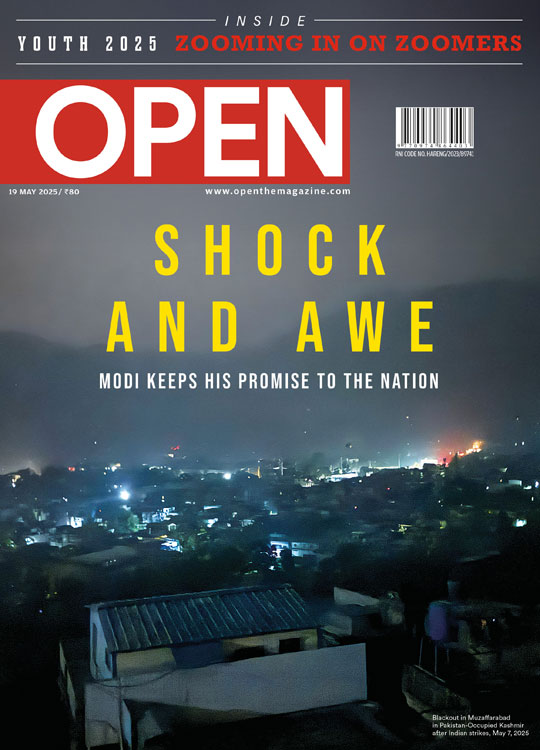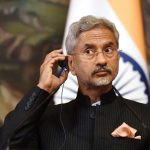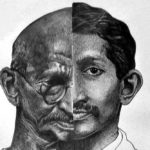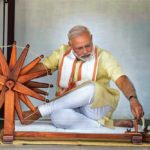Train of Thought
Reliving a rail journey through the freedom struggle
 Lhendup G Bhutia
Lhendup G Bhutia
 Lhendup G Bhutia
Lhendup G Bhutia
 |
27 Sep, 2018
|
27 Sep, 2018
/wp-content/uploads/2018/09/Trainofthought1.jpg)
I AM STANDING TONIGHT AT KALYAN JUNCTION, ON THE periphery of Mumbai, waiting for a train to take me to Rajkot. The night is thick with heat. And the sky drips occasionally with an unseasonal rain. The platform is spilling out with people. There are men seated on the floor in groups of 10, tucking in meals from tiffin boxes, people sprawled on the floor over a bed made of their shawls and newspapers. There are people reading old newspapers, rolling them and swapping flies with it, women walking to and fro nervously as though outside an operation theatre. And children, several of them, running around, placed atop heaps of bags, as though staking a claim to this portion of the platform.
On perhaps a night like this, 103 years ago in January, Mohandas K Gandhi stood at the railway station in Pune, waiting to begin his period of probation. He had given up the clothes of a barrister in South Africa to wear the dress of indentured Indian labourers—a Kathiawadi suit of shirt, dhoti, cloak and scarf, all made of Indian mill cloth. But now even the scarf and the cloak had been shed. These were encumbrances, he believed, if he was going to travel third class in an Indian train. Instead, he had gotten into the habit of wearing a Kashmiri cap that cost no more than 10 annas. ‘One dressed in that fashion,’ Gandhi wrote in his autobiography The Story of My Experiments with Truth, ‘was sure to pass muster as a poor man.’
Gandhi had only just returned from South Africa. And after spending a few days in Bombay, he had travelled to Poona to meet his mentor Gopal Krishna Gokhale—this was going to be the last time he saw Gokhale, who died the following month—who extracted a promise from him. Gandhi was to refrain from any political activity until he had re-acquainted himself with the country. He had, after all, returned to India after two decades.
It is not clear who, between the two, came up with the idea, but it was decided that this reorientation was going to happen through a journey by the most common method of travelling long distances in India then, perhaps even now: third class on the Indian Railways.
There are some accounts which suggest Gandhi wasn’t particularly fond of the Indian Railways. That, he felt, they had helped the British consolidate their grip on the country and facilitated the spread of diseases. But trains often seemed to miraculously transport him to the crucial milestones of his life. In South Africa, thrown out of a train, he decided to fight against the racial segregation of Indians. And now, firmly ensconced in a third-class compartment of an Indian Railways train, he was going to take arguably the most important train ride of the last century in India. He was going to discover India.
This discovery of India, in Richard Attenborough’s Gandhi (1982), takes place in the form of a musical sequence. It is a powerful scene of some five-odd minutes, where Gandhi travels across the length and breadth of the country, sitting by a window, observing the country and its people rush by as the stirring riffs of Ravi Shankar’s sitar play in the background. In truth, however, the train ride was not one continuous journey. It was done in bits and bursts, and did not follow any set route or itinerary. Gandhi went where he needed to go, to meet friends and family members, to attend events and oblige invitations, from Poona to Rajkot, and then on to Santiniketan in West Bengal, to Poona again after he heard of Gokhale’s demise, and from then on to Kolkata and Rangoon, to Haridwar to attend the Kumbh Mela, back to Gujarat to set up his ashram, and so on and so forth. Within this large train journey across India, there were several no doubt smaller trips that were more important than the others. But it all began on a Poona-to-Rajkot train in 1915, a journey of nearly 1,000 km in a third-class compartment, with the plague still prevalent in India, and a trainee Mahatma running a slight fever.
I WAIT FOR THE 11088 PUNE-VERAVAL EXPRESS, retracing the first early steps of Gandhi’s training, travelling on the same route, possibly on the same track. Announcements in various languages come and go. The indicators at the platform light onto life every now and then. But few pay any attention to them today. Most faces are buried instead into cellphones. The status of long-distance trains such as this can now be tracked live, from how many minutes they are late to the station which they are crossing.
In the darkness, suddenly orbs of light discern themselves. A hooting sound rushes. Hundreds of people rise, folding their shawls, putting away their newspapers, lifting their bags, the most distant of them already closing in upon the approaching train. It comes then, this blue groaning machine with yellow boards, slowly, almost like an animal.
There is a scramble at the platform. People realise they have been waiting at incorrect spots. Something comes over me, and I rush away from my designated coach and towards the end of the train where a large crowd has gathered. Jostling and pushing, I jump into the crowded unreserved section.
GANDHI ALWAYS TRAVELLED BY THIRD CLASS, until ailments later in life forced him to take up less uncomfortable options. An unverifiable story goes that when asked why he travelled third class, he would reply, “Because there is no fourth class.” In The Story of My Experiments with Truth, he writes, ‘I have had experiences of third class travelling which, if I wrote them all down, would easily fill a volume.’ To him, it was not just the India outside the window of his train that tutored him. It was also the India within the third-class coach, the India of overcrowded spaces and broken toilets, of people treated like ‘sheep’.
Gandhi wasn’t fond of the Indian Railways. But trains often seemed to miraculously transport him to the crucial milestones of his life
In a book of essays titled Third Class in Indian Railways, Gandhi recounts one such journey, on a Bombay-to-Madras train, where Rs 13 and 9 annas got you a ticket in a third- class compartment meant for 22 passengers, but which very often swelled to 35 passengers. ‘If not more than 22 passengers found their way into my carriage… it was because the bolder ones kept the others at bay… After reaching Raichur, the pressure became unbearable. The rush of passengers could not be stayed. The fighters among us found the task almost beyond them… Some lay on the floor in the midst of dirt and some had to keep standing… The closet was also not cleaned during the journey and there was no water in the water tank… I know passengers who fast while they are travelling just in order to lessen the misery of their life in the trains,’ he writes. ‘Is it any wonder that plague has become endemic in India?’
According to Gandhi, the only way the hardships in third class could be corrected was by getting passengers from the more expensive coaches to travel third. ‘No reform is possible unless some of the educated and the rich voluntarily accept the status of the poor, travel third, refuse to enjoy the amenities denied to the poor…’ he writes.
NOW SO MANY YEARS LATER, A THREE-TIER air-conditioned compartment ticket in my back pocket, I have taken Gandhi’s suggestion. The compartment I have jumped into, at the end of the train, isn’t a compartment of 22 packed with 35 people. This is a peak-hour Mumbai local compartment crowded twice over.
There are of course no third-class compartments in India anymore. All we have now on most trains are air- conditioned coaches, non-air-conditioned sleeper classes where a passenger gets a berth to himself, and overcrowded ‘unreserved compartments’, usually two of them, both near the two ends of the train. Here people who either could not secure a reservation in other compartments or are too poor to afford them travel in agonising conditions. The crowds that jostle to get into these unreserved compartments are so large that it is not unusual to see lathi-wielding railway policemen forcing people in.
The unreserved coach I have got on is miserable. Bodies squash into bodies. There is the smell of sweat and cheap aftershave lotion, which belongs to which one cannot tell. There are just too many bodies—standing, collapsing—by the passages between seats, sprawled out in the space outside the toilets and probably inside. Those who have managed to get in early have managed to secure seats inside. All I have managed is to plant one foot securely onto firm ground. The other, I am not quite sure where I have placed. And unable to find a handle above, my arms cling on, wrapped around someone. I can hear the sound of women and even children.
At some point, I manage to find an overhead handle. And when I look up, I discover, on berths where usually only a single person sleeps in other compartments, rows of at least five pairs of dangling legs, as though seated by a swimming pool. The owners of the legs look on at the crowd below them in large dark unblinking eyes.
We travel like this for a few hours, the only awareness being that of the crush of bodies, the sound of the wheels on track, and the constant noise of ‘Sadko, sadko’ (move, move in Marathi).If there is a world outside this compartment, a window at which Gandhi discovered India, it is blocked by a jumble of bodies. Inside the compartment, no soul can be touched, only cramped bodies felt.
A few hours later, I manage to push myself out at a station. And pushing my way through the crowd at the platform, running, ungainly and unGandhian, my slippers flapping in the dark of night, I manage to find, gasping and sweaty, my designated compartment. Entering it feels like opening the door of a refrigerator in a muggy Mumbai afternoon. Inside, single bodies lie on rows of beds, white railway bedsheets pulled over their heads like corpses in a morgue.
Gandhi’s train journey across India began from Poona in 1915, with the plague still prevalent in India and the Mahatma running a slight fever
I locate my berth only to find it already occupied. The occupant pushes his body to the corner and asks if we can share it. He has a slim body. My Gandhian spirit, however, has left me at the unreserved compartment. I say ‘no’.
Outside, the stations rush by in the darkness. Umroli, Boisar, Vangaon, Dahanu, Gholvad, Bordi—the names trip on my tongue, until it becomes difficult to keep up. Somewhere further inside the coach, I can hear a person whisper to another, “Where are we?”
“Vapi cross,” the person replies loudly. “Gujarat shuru?”
GANDHI’S JOURNEY TO RAJKOT GAVE HIM THE opportunity to encounter the problem that would come to inspire his Satyagraha movement.
There was a customs cordon at Viramgam then. Viramgam is a small city to the west of Gujarat that connects the Kathiawad region to the rest of Gujarat. The British established the Viramgam Line to collect tariff on goods that crossed over the boundaries of princely states in western India. But in reality, it appears, the customs office was often high-handed and frequently harassed commoners taking the train through this part.
When Gandhi reached Viramgam, he was burning with a slight fever. Then, because plague was still prevalent, passengers who took the third class were medically inspected at the station. Gandhi was told to report to the medical officer at Rajkot.
A tailor named Motilal, who was aware that Gandhi was travelling through that region, came to meet him then at the station and told him about the hardships caused by the ViramgamLine. ‘I had little inclination to talk because of my fever,’ Gandhi writes, taking Motilal as ‘one of those impetuous youths who do not think before speaking’ and tried to finish off the conversation.
Motilal however persisted. In time, he captivated Gandhi. And he continued to bring up the customs cordon. In time to come, Gandhi would make a case against the existence of such a cordon, and he kept arguing against it until it was eventually removed in 1917.
‘I regarded this event as the advent of Satyagraha in India,’ Gandhi writes in his autobiography.
THE COMFORTABLE AIR-CONDITIONED COMpartments of the Pune-Veraval Express are not without their characters and the plot twists of their dramas. I wake up in the morning to the sounds of a household with two competing sisters-in-law. Both are travelling with their daughters. And although they are courteous, they throw unsubtle barbs at each other in the form of the high marks their daughters scored in their recent report cards or the gifts their husbands had gotten them. The group exits at the next station.
It is like this throughout the night. The sound of feet shuffling with bags in the dark. The train stops frequently for just a few minutes, and people get on or off, either with or without a ticket, sometimes pinning the travelling ticket examiner at quiet corners using colourful bills with Gandhi’s face decked out in their hands like a spread of cards.
THE COUNTRY OUTSIDE IS PERHAPS NOT TOO different from the one that Gandhi encountered. The small hillocks that one finds in Maharashtra have given way to a flat piece of land. There are large swathes of farmland and sombre hovels covered by black tarpaulin sheets. Small mud houses with cows tethered to posts in their backyards appear every few kilometres. Children here stand at the edge of these shacks and wave at every passing train.
But then soon, as the morning brightens between the trees and concrete buildings, the landscape alters. The people change, their dresses reshape, houses and office buildings turn to hovels, and neat rows of farmland give way to the wild invasion of weeds and bushes. The modern cityscape of the area around Ahmedabad station, where people live in concrete houses with glass shards embedded into their terrace walls, turns poorer and poorer into shacks with roofs that are held down by stones. White cranes swim in marshy pools of plastic bottles. And the men begin to look morose.
The pastoral world soon becomes barren. The ground turns redder, acres and acres of red nothingness. For several hours all one can see is nothing but a woman with bare feet carrying a load of firewood on her head with her child trailing behind.
Below us, the track thrums with life. The spine of the train races and swerves.
WHAT WAS GANDHI DOING TRAVELLING TO Rajkot with a fever? In his book, he claims he was going to Rajkot and then to Porbandar to meet his brother’s widow and other relatives. Could it also be to relive old childhood memories?
Rajkot has other sentimental attachments for Gandhi. As a child, he lived for several years in a quaint little neighbourhood of tiny alleys and old buildings, in a pretty house with a courtyard. And just minutes away was Alfred High School, the school he graduated from at 18.
The school continues to stand. And so too does Gandhi’s house and the neighbourhood around it—its long identical alleys and its old-world charm.
THERE IS MUCH ABOUT TRAIN TRAVEL THAT has remained unchanged. Although there is plenty more that has.
Songs and radio tunes still play on, although from cellphones. Men still run out whenever the train halts, perhaps a tic from our hunting-gathering days, with empty bottles and searching eyes, looking for drinking water and meals for the wives and children they have left behind in the trains. The bags are still the same, bulky and without wheels. The conversations are long and animated. Strangers still stand one another for cups of tea, the very strangers who might have a go at each other for a common hand-rest seated aboard an aircraft. Eunuchs, mendicants, sadhus and wandering musicians still raid the compartments every few stations.
But there are several changes too. There are no reservation charts plastered on every coach anymore. Intimations arrive on phones instead. Train staff walk from berth to berth, taking deep breaths and shooting out a room freshener whenever unsatisfied. In a few years, a Japanese-made Bullet train is expected to connect large parts of this stretch.
WHEN GANDHI REACHED RAJKOT, HE HAD TO report himself to the medical officer. ‘I was not unknown there,’ he writes, somewhat amused. ‘The Doctor felt ashamed and was angry with the inspector.’
I reach Rajkot station only a few minutes behind schedule. It is a large, clean station. There are no medical officers but plenty of policemen. Just a few kilometres away, at Gandhi’s ancestral home, the old caretaker insists on guiding every visitor but turns down tips. He points instead to the visitor’s book. Its last entry reads, ‘Every glitter is not gold. But Bapu is pure 24 carat gold.’

/wp-content/uploads/2025/05/Cover-War-Shock-1.jpg)













More Columns
On Being Young Surya San
Why Are Children Still Dying of Rabies in India? V Shoba
India holds the upper hand as hostilities with Pakistan end Rajeev Deshpande